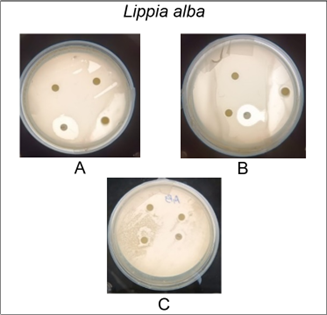Variación estacional del rendimiento de extracción y actividad biológica in vitro del aceite esencial de Lippia alba (pampa orégano)
DOI:
https://doi.org/10.55996/dekamuagropec.v5i2.273Palabras clave:
Hidrodestilación, capacidad antioxidante, actividad antibacteriana, compuestos fenólicosResumen
Los aceites esenciales (AE) son una mezcla compleja de compuestos aromáticos y volátiles, debido a sus propiedades biológicas están ganando interés como una alternativa potencial y viable dentro de la producción de alimentos en la categoría de aditivos con tendencia natural. La investigación tuvo como objetivo estimar el rendimiento de extracción en dos épocas del año (estación seca y lluviosa) y la actividad biológica in vitro del AE de Lippia alba (pampa orégano). La extracción del AE se realizó por hidrodestilación (equipo Clevenger), se evaluó la actividad antibacteriana in vitro por el método de difusión en disco frente a tres especies bacterianas asociadas con el deterioro de alimentos Escherichia coli, Salmonella enteritidis y Staphylococcus aureus, se determinó la capacidad antioxidante mediante los ensayos DPPH, FRAP, ABTS y el contenido total de compuestos fenólicos por el método de Folin-Ciocalteu. Los resultados mostraron un incremento en el rendimiento de extracción de 106.3% para la época lluviosa. El AE exhibió una actividad baja frente a las bacterias estudiadas y la capacidad antioxidante mostró resultados diferenciados, para DPPH 12.24 µmol Trolox/g, FRAP 57.64 µmol Fe2+/g muestra, ABTS 14.41 µmol Trolox/g muestra y 72.69 mg ácido gálico/g muestra con respecto al contenido de compuestos fenólicos.
Descargas
Citas
Araujo Baptista, L. M., Rondón Rivas, M. E., Cruz Tenempaguay, R. E., Guayanlema Chávez, J. D., Vargas Córdova, C. A., Morocho Zaragocin, S. V., & Cornejo Sotomayor, X. (2019). Antimicrobial activity of the essential oil of piper amalago l. (piperaceae) collected in coastal ecuador. Pharmacologyonline, 3, 15–27.
Armijos, C., Valarezo, E., Cartuche, L., Zaragoza, T., Finzi, P. V., Mellerio, G. G., & Vidari, G. (2018). Chemical composition and antimicrobial activity of Myrcianthes fragrans essential oil, a natural aromatizer of the traditional Ecuadorian beverage colada morada. Journal of Ethnopharmacology, 225, 319–326. https://doi.org/10.1016/j.jep.2018.07.018
Aular, Y., Villamizar, M., Pérez, Y., & Pérez, V. (2016). Composición química y toxicidad aguda oral del aceite esencial de Lippia alba en ratones. Salus, 20(1), 43–51.
Benzie, I. F. F., & Strain, J. J. (1996). The Ferric Reducing Ability of Plasma (FRAP) as a Measure of “Antioxidant Power”: The FRAP Assay. Analytical Biochemistry, 239(1), 70–76. https://doi.org/10.1006/abio.1996.0292
Burt, S. (2004). Essential oils: their antibacterial properties and potential applications in foods—a review. International Journal of Food Microbiology, 94(3), 223–253. https://doi.org/10.1016/j.ijfoodmicro.2004.03.022
Bussmann, R. W., Glenn, A., Sharon, D., Chait, G., Díaz, D., Pourmand, K., Jonat, B., Somogy, S., Guardado, G., Aguirre, C., Chan, R., Meyer, K., Rothrock, A., & Townesmith, A. (2011). Proving that traditional knowledge works: The antibacterial activity of Northern Peruvian medicinal plants. Ethnobotany Research and Applications, 9, 67–98. https://doi.org/10.17348/era.9.0.67-96
Castro–Alayo, E. M., Chávez–Quintana, S. G., Auquiñivín-Silva, E. A., Fernández-Jeri, A. B., Acha-De la Cruz, O., Rodríguez-Hamamura, N., & Olivas-Orozco, G. (2019). Essential oils of native plants from Peru: Effect of the place of cultivation on the physicochemical characteristics and antioxidant activity. Scientia Agropecuaria, 10(4), 479–487. https://doi.org/10.17268/sci.agropecu.2019.04.04
Clinical and Laboratory Standards Institute. (2012). Performance standards for antimicrobial disk susceptibility tests: Approved standard - Eleventh edition (Vol. 32, Issue 1). https://doi.org/M02-A11
El Ahrar, A. (2016). Variación estacional del aceite esencial obtenido de diferentes quimiotipos de Mentha longifolia L.
Fang, Z., Yang, Y., Lin, S., Xu, L., Chen, S., Lv, W., Wang, N., Dong, S., Lin, C., Xie, Y., Liu, J., Meng, M., Wen, W., & Yang, Y. (2025). Development and antimicrobial activity of composite edible films of chitosan and nisin incorporated with perilla essential oil-glycerol monolaurate emulsions. Food Chemistry, 462, 141006. https://doi.org/10.1016/j.foodchem.2024.141006
Fernández Rosillo, F., Quiñones Huatangari, L., Ojeda Gaona, T. S., Alfaro Montero, D. del P., Yalta Meza, R. J., Cabrejos Barrios, E. M., & Huamán Mera, A. (2024). Rendimiento de extracción por hidrodestilación del aceite esencial de Piper aduncum L. (matico) mediante un modelo cinético. Revista Científica Dékamu Agropec, 5(1), 33–44. https://doi.org/10.55996/dekamuagropec.v5i1.208
Gavahian, M., Chu, Y.-H., Lorenzo, J. M., Mousavi Khaneghah, A., & Barba, F. J. (2020). Essential oils as natural preservatives for bakery products: Understanding the mechanisms of action, recent findings, and applications. Critical Reviews in Food Science and Nutrition, 60(2), 310–321. https://doi.org/10.1080/10408398.2018.1525601
Glamočlija, J., Soković, M., Teević, V., Linde, G. A., & Colauto, N. B. (2011). Chemical characterization of Lippia alba essential oil: an alternative to control green molds. Brazilian Journal of Microbiology, 42(4), 1537–1546. https://doi.org/10.1590/S1517-83822011000400041
Guerrini, A., Sacchetti, G., Rossi, D., Paganetto, G., Muzzoli, M., Andreotti, E., Tognolini, M., Maldonado, M. E., & Bruni, R. (2009). Bioactivities of Piper aduncum L. and Piper obliquum Ruiz & Pavon (Piperaceae) essential oils from Eastern Ecuador. Environmental Toxicology and Pharmacology, 27(1), 39–48. https://doi.org/10.1016/j.etap.2008.08.002
Jayasena, D. D., & Jo, C. (2013). Essential oils as potential antimicrobial agents in meat and meat products: A review. Trends in Food Science & Technology, 34(2), 96–108. https://doi.org/10.1016/j.tifs.2013.09.002
Kloucek, P., Polesny, Z., Svobodova, B., Vlkova, E., & Kokoska, L. (2005). Antibacterial screening of some Peruvian medicinal plants used in Callería District. Journal of Ethnopharmacology, 99(2), 309–312. https://doi.org/10.1016/j.jep.2005.01.062
Konfo, T. R. C., Djouhou, F. M. C., Koudoro, Y. A., Dahouenon-Ahoussi, E., Avlessi, F., Sohounhloue, C. K. D., & Simal-Gandara, J. (2023). Essential oils as natural antioxidants for the control of food preservation. Food Chemistry Advances, 2, 100312. https://doi.org/10.1016/j.focha.2023.100312
Lam-Gutiérrez, A., Ayora-Talavera, T., Garrido-Ramírez, E. R., Ruíz-Valdiviezo, V. M., Guzmán-Albores, J. M., & Cristóbal-Alejo, J. (2024). Chemical composition and antifungal activity of essential oils extracted from Pimenta dioica and Piper auritum leaves grown in Mexico. Cogent Food & Agriculture, 10(1). https://doi.org/10.1080/23311932.2024.2356935
Liao, Z., Huang, Q., Cheng, Q., Khan, S., & Yu, X. (2021). Seasonal Variation in Chemical Compositions of Essential Oils Extracted from Lavandin Flowers in the Yun-Gui Plateau of China. Molecules, 26(18), 5639. https://doi.org/10.3390/molecules26185639
Lin, C.-W., Yu, C.-W., Wu, S.-C., & Yih, K.-H. (2020). DPPH free-radical scavenging activity, total phenolic contents and chemical composition analysis of forty-two kinds of essential oils. Journal of Food and Drug Analysis, 17(5). https://doi.org/10.38212/2224-6614.2594
Linde, G. A., Colauto, N. B., Albertó, E., & Gazim, Z. C. (2016). Quimiotipos, Extracción, Composición y Aplicaciones del Aceite Esencial de Lippia alba. Revista Brasileira de Plantas Medicinais, 18(1), 191–200. https://doi.org/10.1590/1983-084X/15_037
López-Hernández, M., Criollo-Nuñez, J., Beltran, J. I., & Sandoval-Aldana, A. (2024). Chemical composition and antioxidant activity of ‘Nufar’ basil (Ocimum basilicum L.) essential oil from three municipalities of Tolima, Colombia. Food Chemistry Advances, 5, 100819. https://doi.org/10.1016/j.focha.2024.100819
López, P. L., Reinante, R. D., Grosso, N. R., & Olmedo, R. H. (2021). Tendencias en la percepción de los consumidores y adquirientes sobre los aditivos alimentarios. Nexo Agropecuario, 9(1), 45–51.
Mamun-Or-Rashid, A. N. M., Sen, M. K., Jamal, M. A. H. M., & Nasrin, S. (2013). A Comprehensive Ethnopharmacological Review on Lippia Alba M. International Journal of Biomedical Materials Research, 1(1), 14. https://doi.org/10.11648/j.ijbmr.20130101.13
Martínez, A. (2003). Aceites Esenciales. División de Publicaciones UIS, 180. https://bit.ly/3y1JZRg
Marzo Rojas, I. (2010). Efecto del tipo y conocimiento de aceites esenciales sobre las propiedades mecánicas y barrera de películas comestibles basadas en zeína.
Ozdikmenli, S., & Demirel Zorba, N. N. (2016). Evaluation of usage of essential oils instead of spices in meat ball formulation for controlling Salmonella spp. Food Science and Technology International, 22(2), 93–101. https://doi.org/10.1177/1082013215571118
Pascual, M. E., Slowing, K., Carretero, E., Sánchez Mata, D., & Villar, A. (2001). Lippia: traditional uses, chemistry and pharmacology: a review. Journal of Ethnopharmacology, 76(3), 201–214. https://doi.org/10.1016/S0378-8741(01)00234-3
Pateiro, M., Barba, F. J., Domínguez, R., Sant’Ana, A. S., Mousavi Khaneghah, A., Gavahian, M., Gómez, B., & Lorenzo, J. M. (2018). Essential oils as natural additives to prevent oxidation reactions in meat and meat products: A review. Food Research International, 113, 156–166. https://doi.org/10.1016/j.foodres.2018.07.014
Pérez Cordero, A., Chamorro Anaya, L., & Vitola Romero, D. (2017). Caracterización química y evaluación de la actividad antifúngica del aceite esencial foliar de Lippia alba contra Colletotrichum gloeosporioides. Revista Peruana de Biología, 24(2), 211–216. https://doi.org/10.15381/rpb.v24i2.13499
Perigo, C. V., Torres, R. B., Bernacci, L. C., Guimarães, E. F., Haber, L. L., Facanali, R., Vieira, M. A. R., Quecini, V., & Marques, M. O. M. (2016). The chemical composition and antibacterial activity of eleven Piper species from distinct rainforest areas in Southeastern Brazil. Industrial Crops and Products, 94, 528–539. https://doi.org/10.1016/j.indcrop.2016.09.028
Pezo-Pérez, N. L., & Gonzales-Coral, A. (2016). Caracterización agronómica de pamoa orégano Lippia alba (Mill). Folia Amazónica, 9(1–2), 179. https://doi.org/10.24841/fa.v9i1-2.175
Pinheiro, C. G., Machado, C. M., Amaral, L. P., Silva, D. T., Almeida, C. A. A., Longhi, S. J., Mallmann, C. A., & Heinzmann, B. M. (2016). Seasonal variability of the essential oil of Hesperozygis ringens (Benth.) Epling. Brazilian Journal of Biology, 76(1), 176–184. https://doi.org/10.1590/1519-6984.16314
Proestos, C., Lytoudi, K., Mavromelanidou, O., Zoumpoulakis, P., & Sinanoglou, V. (2013). Antioxidant Capacity of Selected Plant Extracts and Their Essential Oils. Antioxidants, 2(1), 11–22. https://doi.org/10.3390/antiox2010011
Ramírez A., L. S., & Díaz B., H. E. (2007). Actividad antibacteriana de extractos y fracciones del ruibarbo (Rumex conglomeratus). Scientia, 33, 397–400.
Rao, B. R. R., Kaul, P. N., Syamasundar, K. V., & Ramesh, S. (2005). Chemical profiles of primary and secondary essential oils of palmarosa (Cymbopogon martinii (Roxb.) Wats var. motia Burk.). Industrial Crops and Products, 21(1), 121–127. https://doi.org/10.1016/j.indcrop.2004.02.002
Re, R., Pellegrini, N., Proteggente, A., Pannala, A., Yang, M., & Rice-Evans, C. (1999). Antioxidant activity applying an improved ABTS radical cation decolorization assay. Free Radical Biology and Medicine, 26(9–10), 1231–1237. https://doi.org/10.1016/S0891-5849(98)00315-3
Requelme Bautista, M. C. (2020). Efecto antibateriano in vitro del extracto etanólico de hojas de Lantana camara (hierba de la maestranza) sobre Staphylococcus aureus. Universidad Cátolica los Ángeles Chimbote.
Ruiz, C., Díaz, C., & Rojas, R. (2015). Composición Química De Aceites Esenciales De 10 Plantas Aromáticas Peruanas. Revista de La Sociedad Química Del Perú, 81(2), 81–94. https://doi.org/10.37761/rsqp.v81i2.10
Sánchez Aldana, D., Contreras-Esquivel, J. C., Nevárez-Moorillón, G. V., & Aguilar, C. N. (2015). Caracterización de películas comestibles a base de extractos pécticos y aceite esencial de limón Mexicano. CyTA - Journal of Food, 13(1), 17–25. https://doi.org/10.1080/19476337.2014.904929
Scherer, R., & Godoy, H. T. (2009). Antioxidant activity index (AAI) by the 2,2-diphenyl-1-picrylhydrazyl method. Food Chemistry, 112(3), 654–658. https://doi.org/10.1016/j.foodchem.2008.06.026
Setzer, W. N., Park, G., Agius, B. R., Stokes, S. L., Walker, T. M., & Haber, W. A. (2008). Chemical Compositions and Biological Activities of Leaf Essential Oils of Twelve Species of Piper from Monteverde, Costa Rica. Natural Product Communications, 3(8). https://doi.org/10.1177/1934578X0800300823
Sinche Ambrosio, C. M. (2020). Unravelling the potential of citrus essential oils derived from citrus processing as an alternative antimicrobial feed additive in pigs [Universidade de São Paulo]. https://doi.org/10.11606/T.11.2020.tde-18052020-151325
Singleton, V. L., Orthofer, R., & Lamuela-Raventós, R. M. (1999). [14] Analysis of total phenols and other oxidation substrates and antioxidants by means of folin-ciocalteu reagent (pp. 152–178). https://doi.org/10.1016/S0076-6879(99)99017-1
Smitha, G. R., & Vandana, T. (2016). Seasonal variation in the essential oils extracted from leaves and inflorescence of different Ocimum species grown in Western plains of India. Industrial Crops and Products, 94, 52–64. https://doi.org/10.1016/j.indcrop.2016.07.041
Solís-Quispe, L., Pino, J. A., Falco, A. S., Tomaylla-Cruz, C., Quispe-Tonccochi, E. G., Solís-Quispe, J. A., Aragón-Alencastre, L. J., & Solís-Quispe, A. (2019). Chemical composition and antibacterial activities of essential oil from Ageratina pentlandiana (DC.) R.M. King & H. Rob. leaves grown in the Peruvian Andes. Journal of Essential Oil Research, 31(5), 409–413. https://doi.org/10.1080/10412905.2019.1593891
Solis-Quispe, L., Solis-Quispe, J. A., Tomaylla-Cruz, C., Aragon-Alencastre, L. J., Rodríguez, J. L., & Pino, J. A. (2018). Chemical Composition and Antioxidant Activity of the Essential Oil from Hedeoma mandoniana Grown in Cuzco. Natural Product Communications, 13(12). https://doi.org/10.1177/1934578X1801301235
Solis-Quispe, L., Tomaylla-Cruz, C., Callo-Choquelvica, Y., Solís-Quispe, A., Rodeiro, I., Hernández, I., Fernández, M. D., & Pino, J. A. (2016). Chemical composition, antioxidant and antiproliferative activities of essential oil from Schinus areira L. and Minthostachys spicata (Benth.) Epl. grown in Cuzco, Peru. Journal of Essential Oil Research, 28(3), 234–240. https://doi.org/10.1080/10412905.2015.1120691
Sotelo Mendez, A. H., Figueroa Cornejo, C. G., Césare Coral, M. F., & Alegría Arnedo, M. C. (2017). Chemical composition, antimicrobial and antioxidant activities of the essential oil of bursera graveolens (burseraceae) from Perú. Indian Journal of Pharmaceutical Education and Research, 51(3), S429–S436. https://doi.org/10.5530/ijper.51.3s.62
Souza, H. F. de, Santos, F. R. dos, Cunha, J. S., Pacheco, F. C., Pacheco, A. F. C., Soutelino, M. E. M., Martins, C. C. N., Andressa, I., Rocha, R. da S., Cruz, A. G. da, Paiva, P. H. C., Brandi, I. V., & Kamimura, E. S. (2024). Microencapsulation to Harness the Antimicrobial Potential of Essential Oils and Their Applicability in Dairy Products: A Comprehensive Review of the Literature. Foods, 13(14), 2197. https://doi.org/10.3390/foods13142197
Teles, S., Pereira, J. A., Santos, C. H. B., Menezes, R. V., Malheiro, R., Lucchese, A. M., & Silva, F. (2012). Geographical origin and drying methodology may affect the essential oil of Lippia alba (Mill) N.E. Brown. Industrial Crops and Products, 37(1), 247–252. https://doi.org/10.1016/j.indcrop.2011.12.029
Yasunaka, K., Abe, F., Nagayama, A., Okabe, H., Lozada-Pérez, L., López-Villafranco, E., Muñiz, E. E., Aguilar, A., & Reyes-Chilpa, R. (2005). Antibacterial activity of crude extracts from Mexican medicinal plants and purified coumarins and xanthones. Journal of Ethnopharmacology, 97(2), 293–299. https://doi.org/10.1016/j.jep.2004.11.014

Descargas
Publicado
Cómo citar
Número
Sección
Licencia
Derechos de autor 2024 Frank Fernández-Rosillo, Elza Berta Aguirre-Vargas

Esta obra está bajo una licencia internacional Creative Commons Atribución 4.0.
Los autores que publican en esta revista aceptan los siguientes términos:
- Los autores conservan los derechos de autor y conceden a la revista el derecho publicación con la obra, simultáneamente licenciada bajo una licencia de Creative Commons CC By que permite a otros compartir el trabajo, pero citando la publicación inicial en esta revista.
- Los autores pueden celebrar acuerdos contractuales adicionales separados para la distribución no exclusiva de la versión publicada de la obra de la revista (por ejemplo, publicarla en un repositorio institucional o publicarla en un libro), pero citando la publicación inicial en esta revista.
- Se permite y anima a los autores a publicar su trabajo en línea (por ejemplo, en repositorios institucionales o en su sitio web) antes y durante el proceso de presentación, ya que puede conducir a intercambios productivos, así como una mayor citación del trabajo publicado (https://web-archive.southampton.ac.uk/opcit.eprints.org/oacitation-biblio.html)














